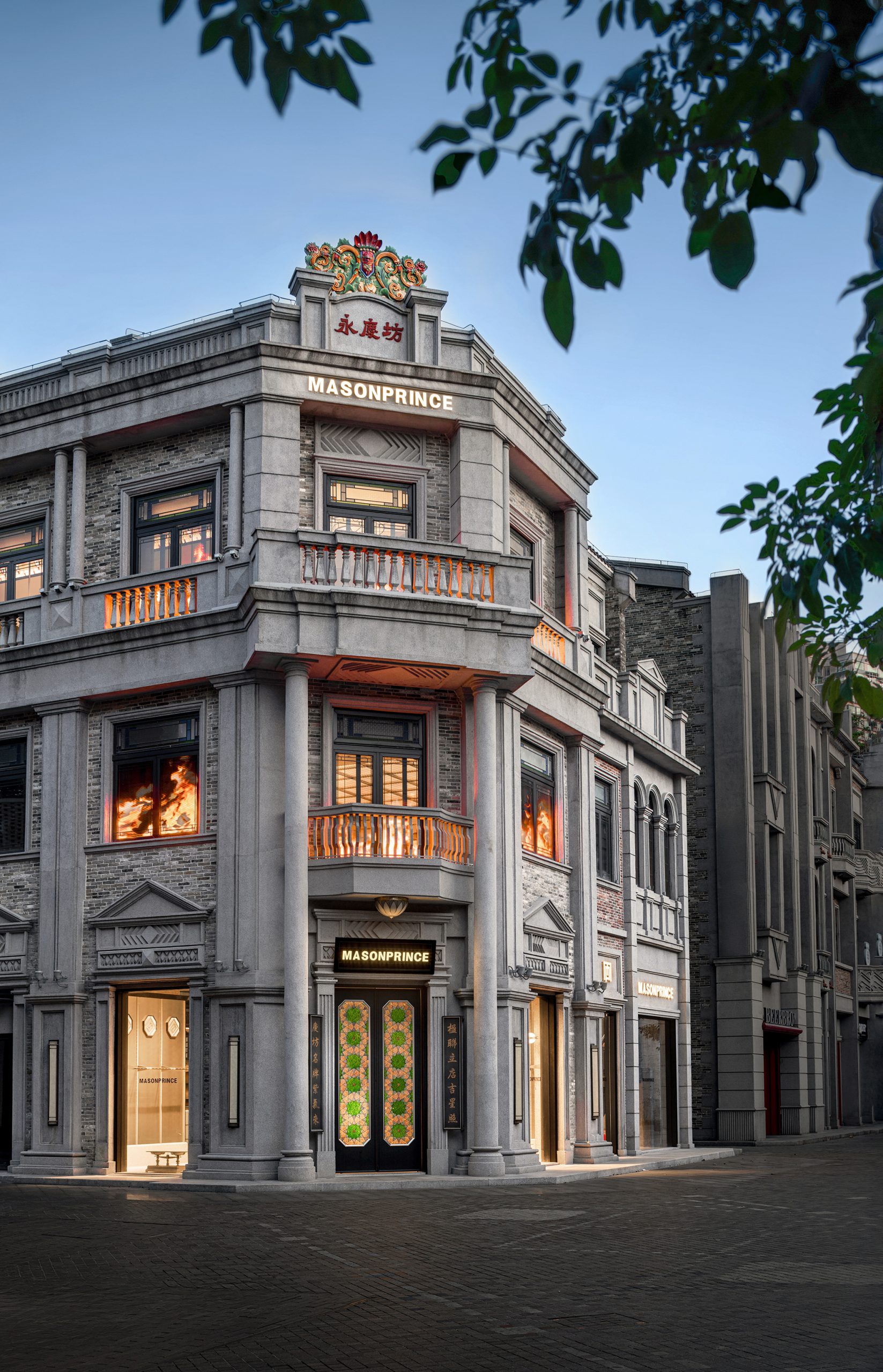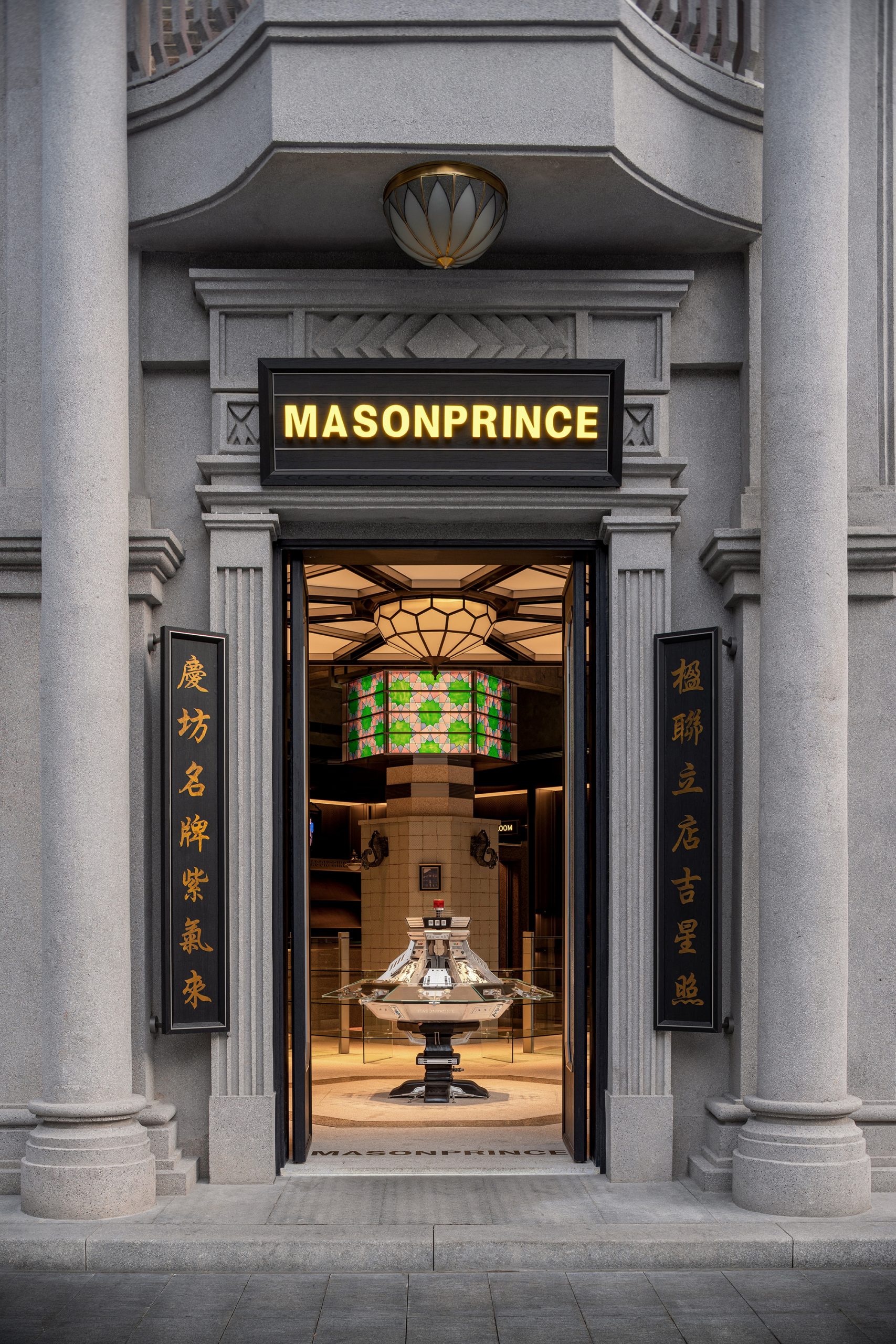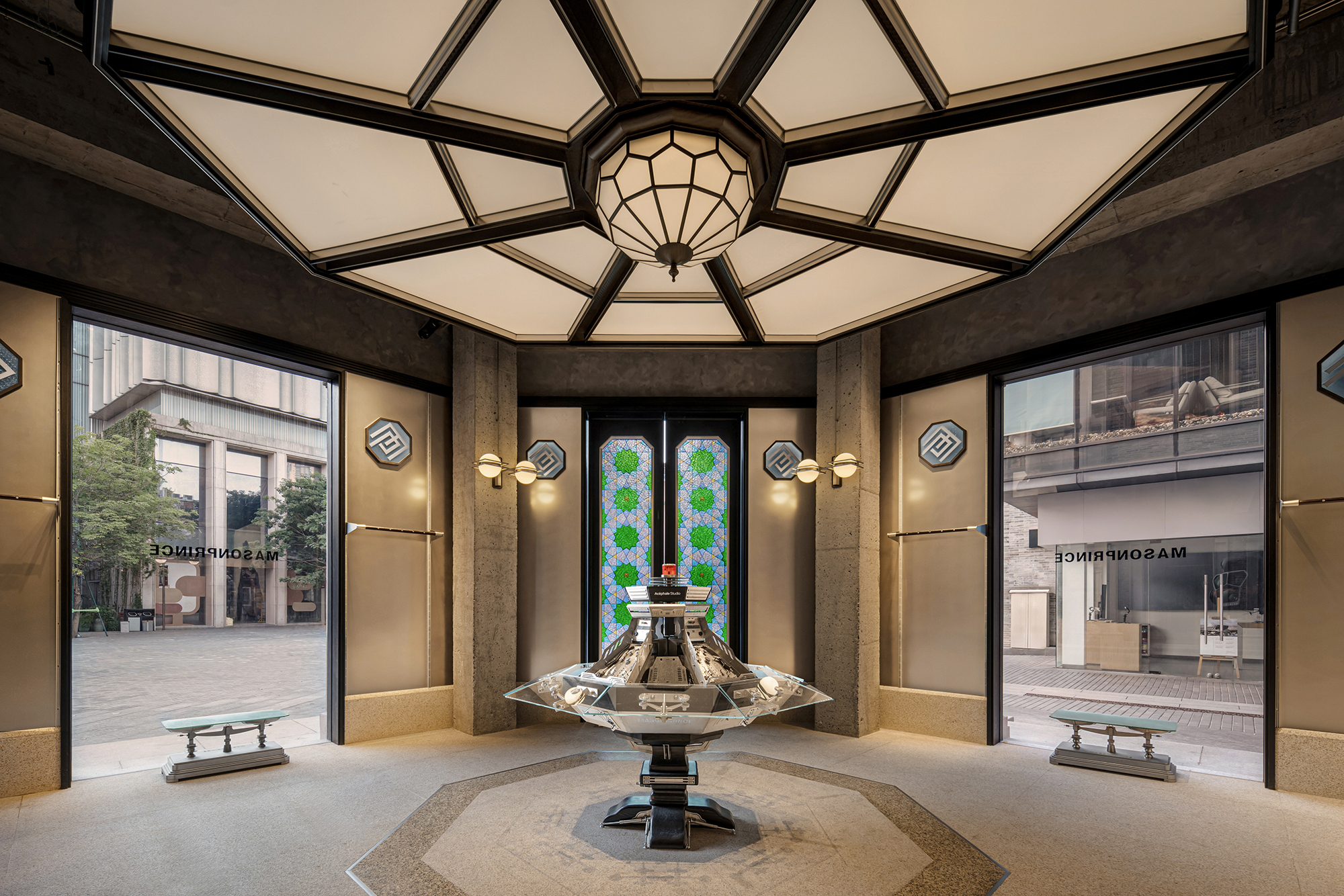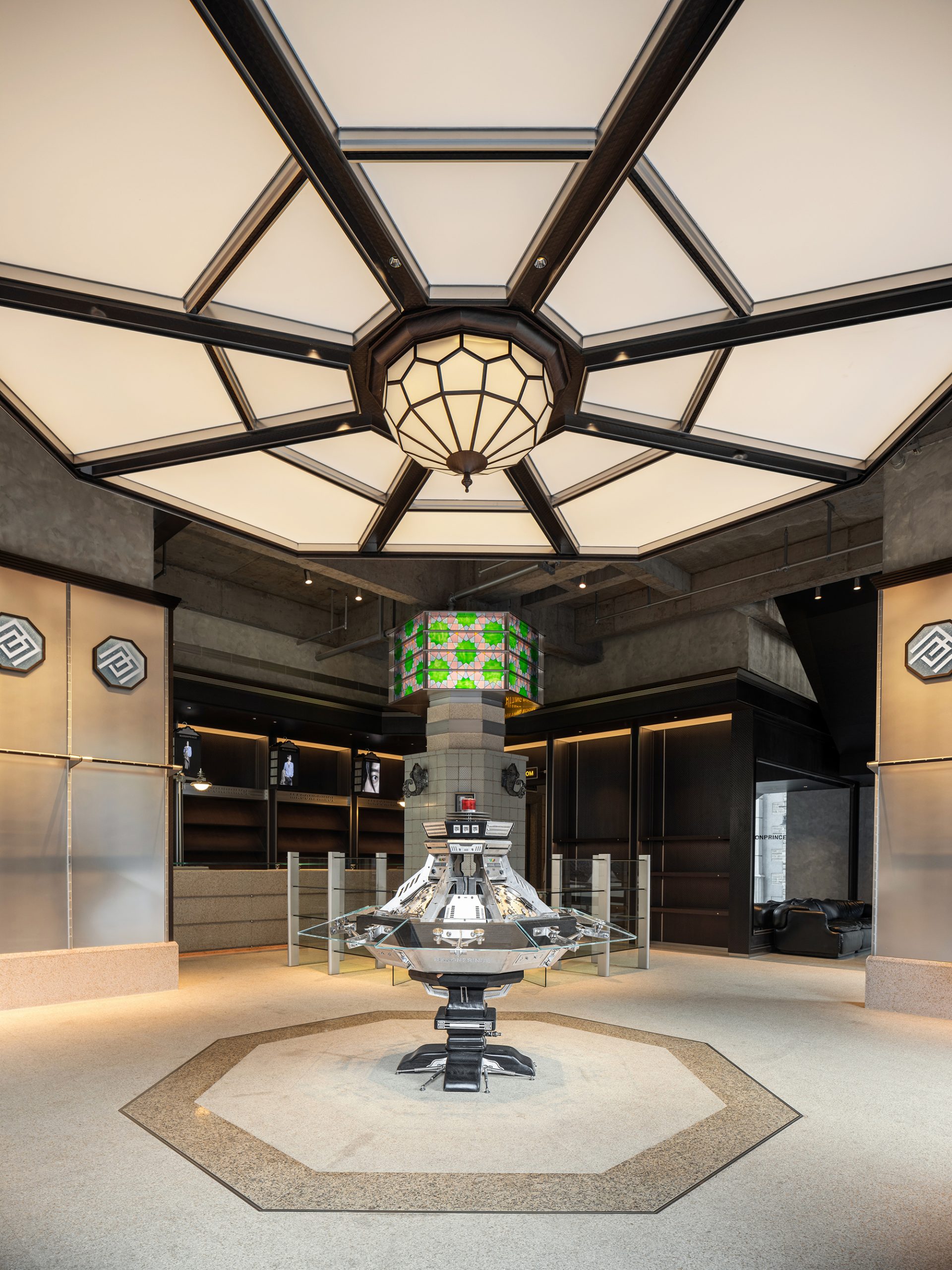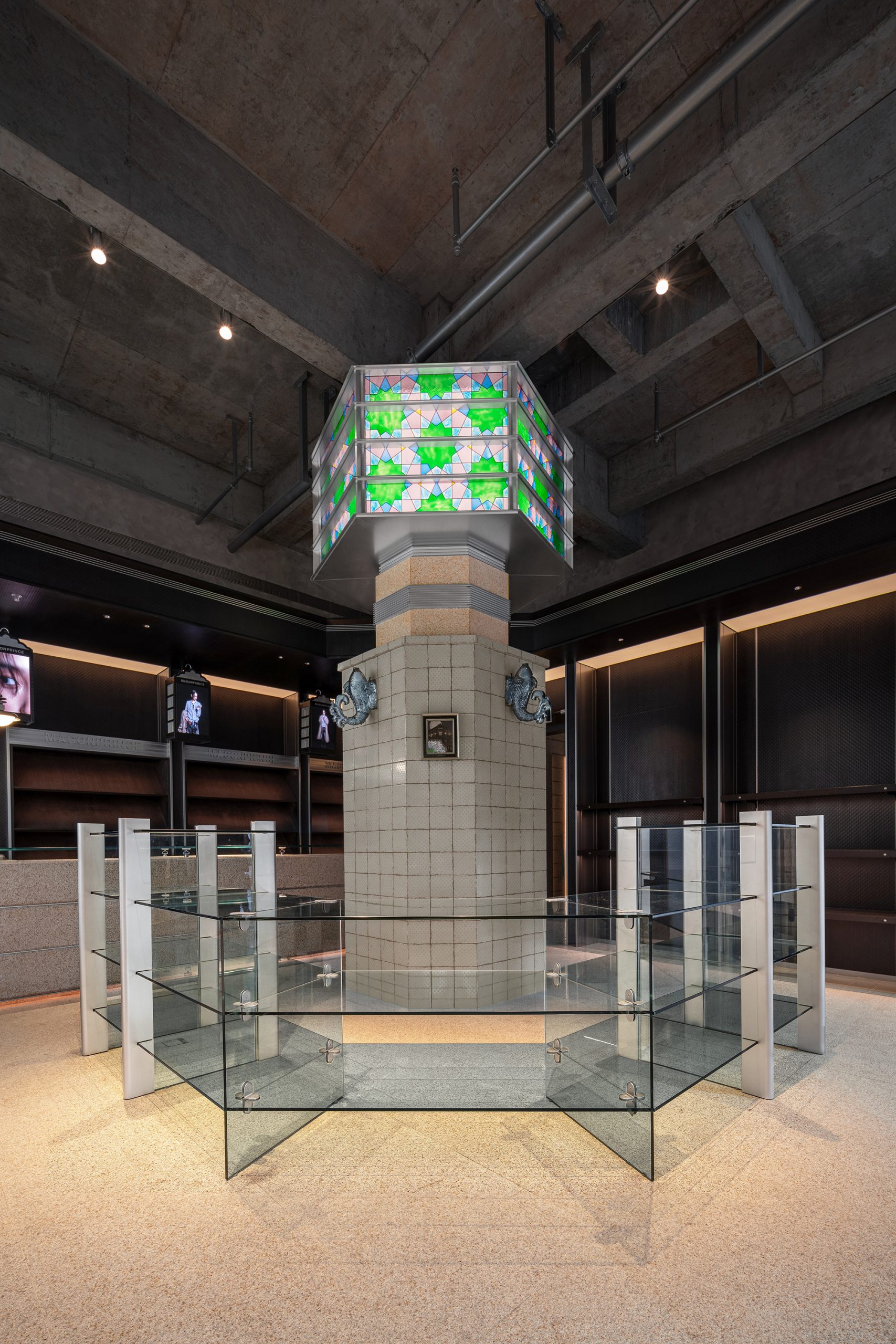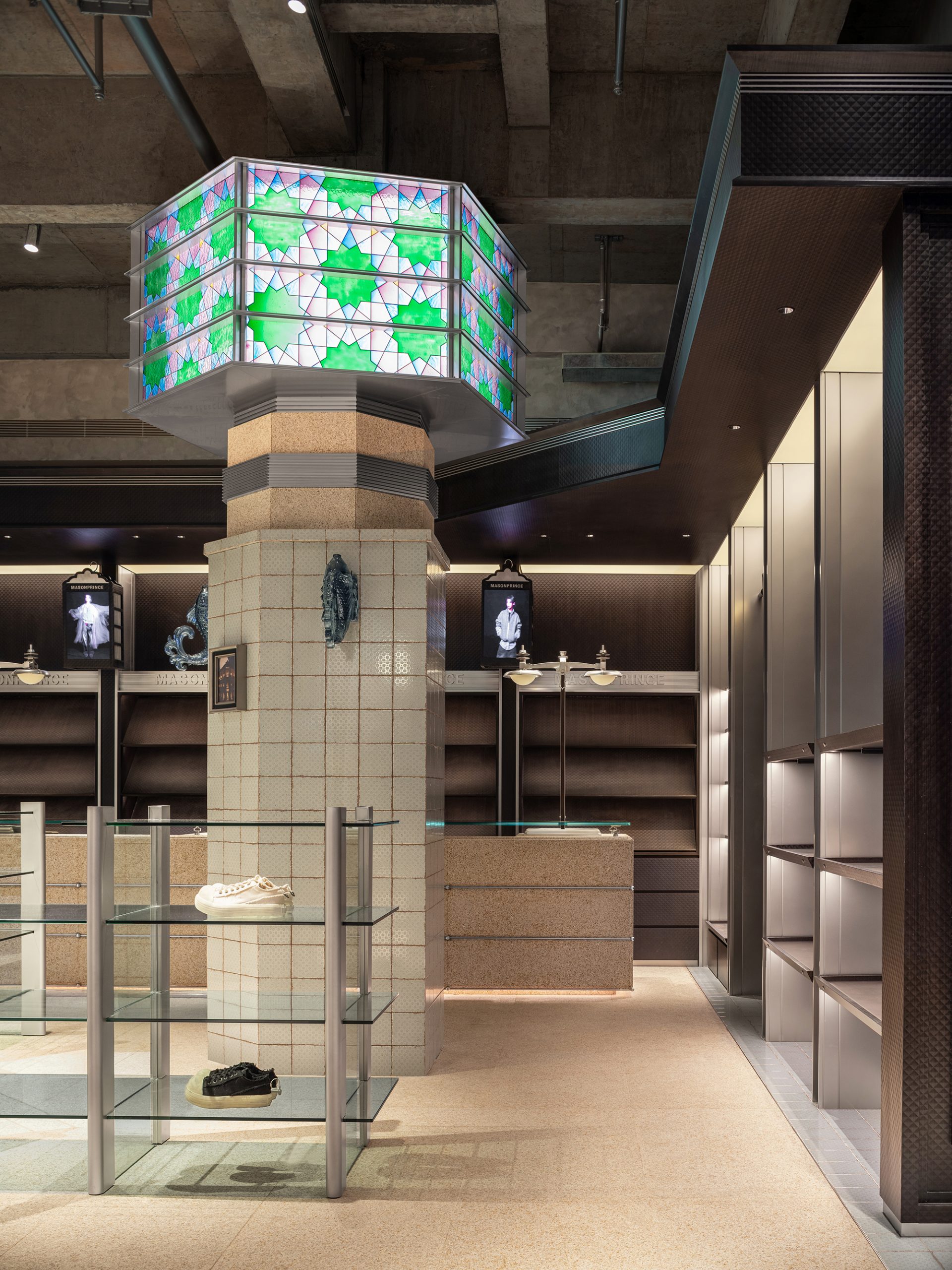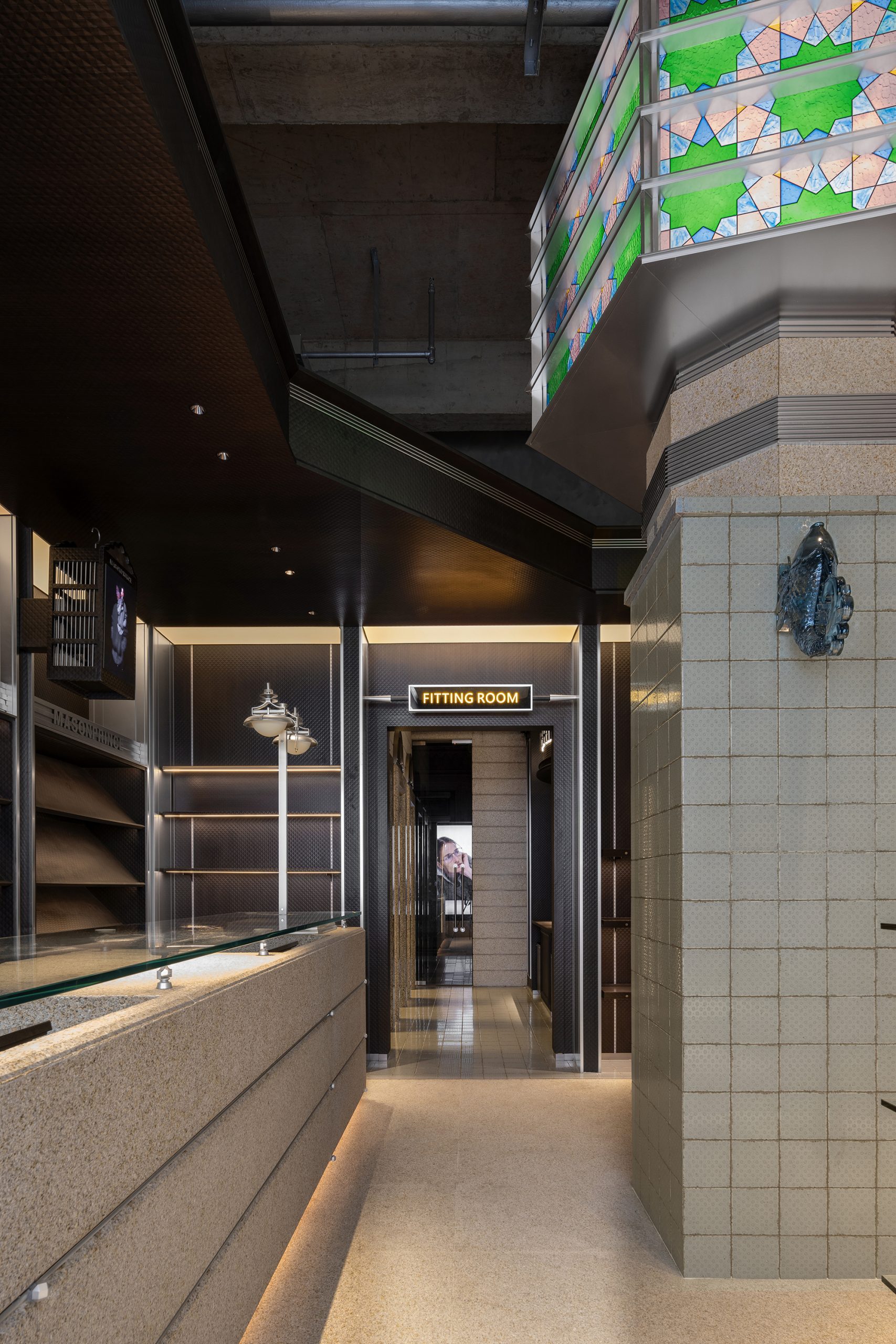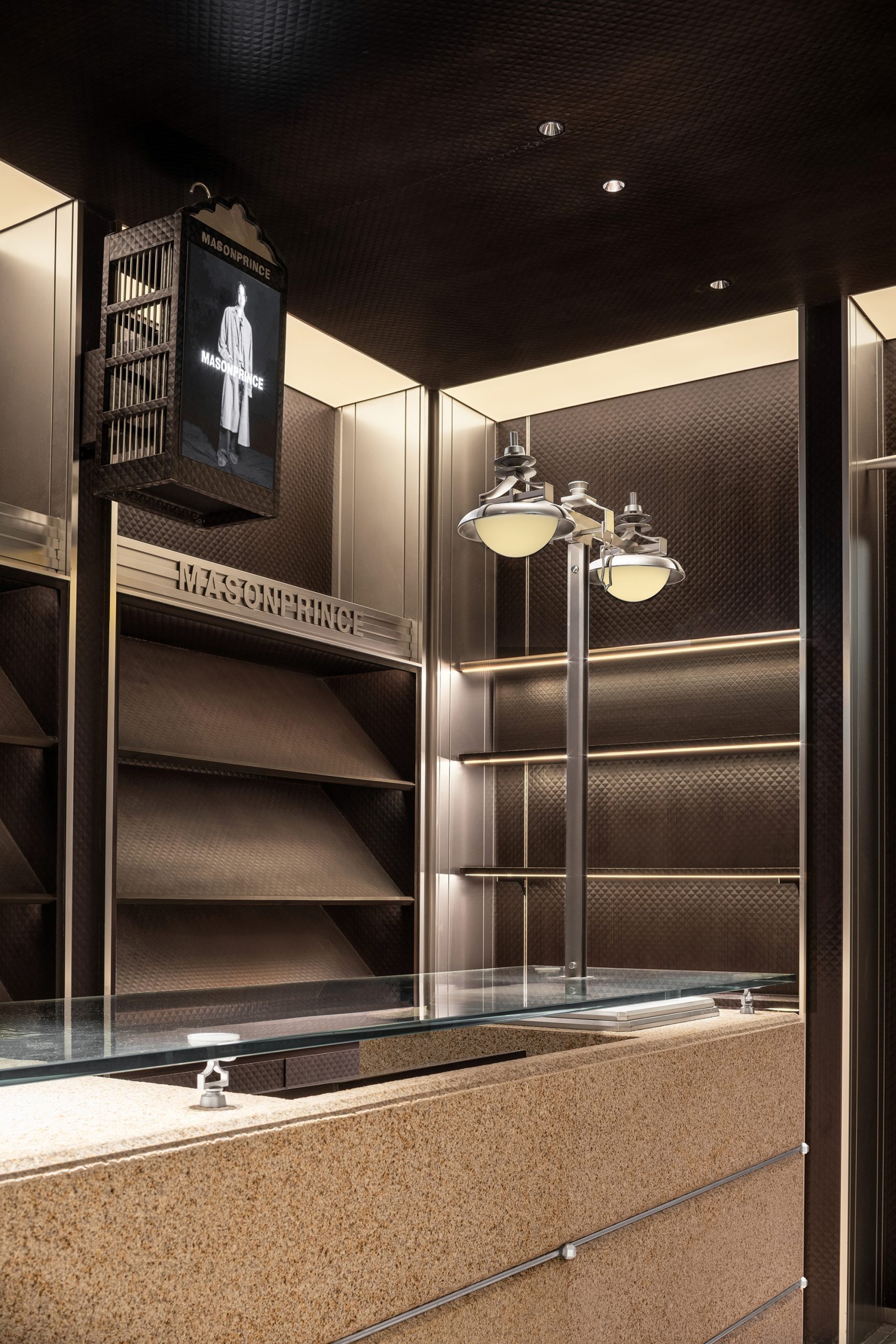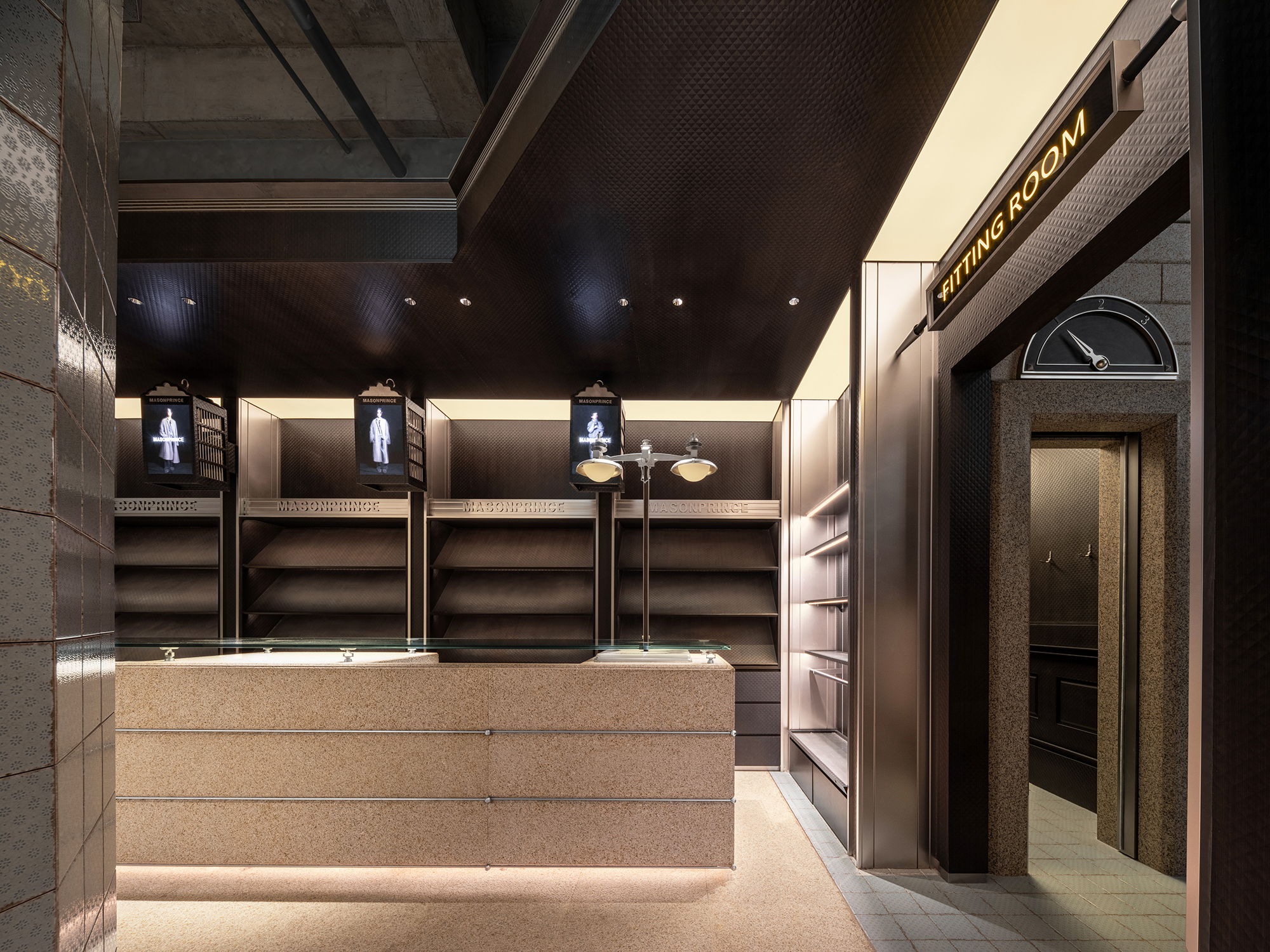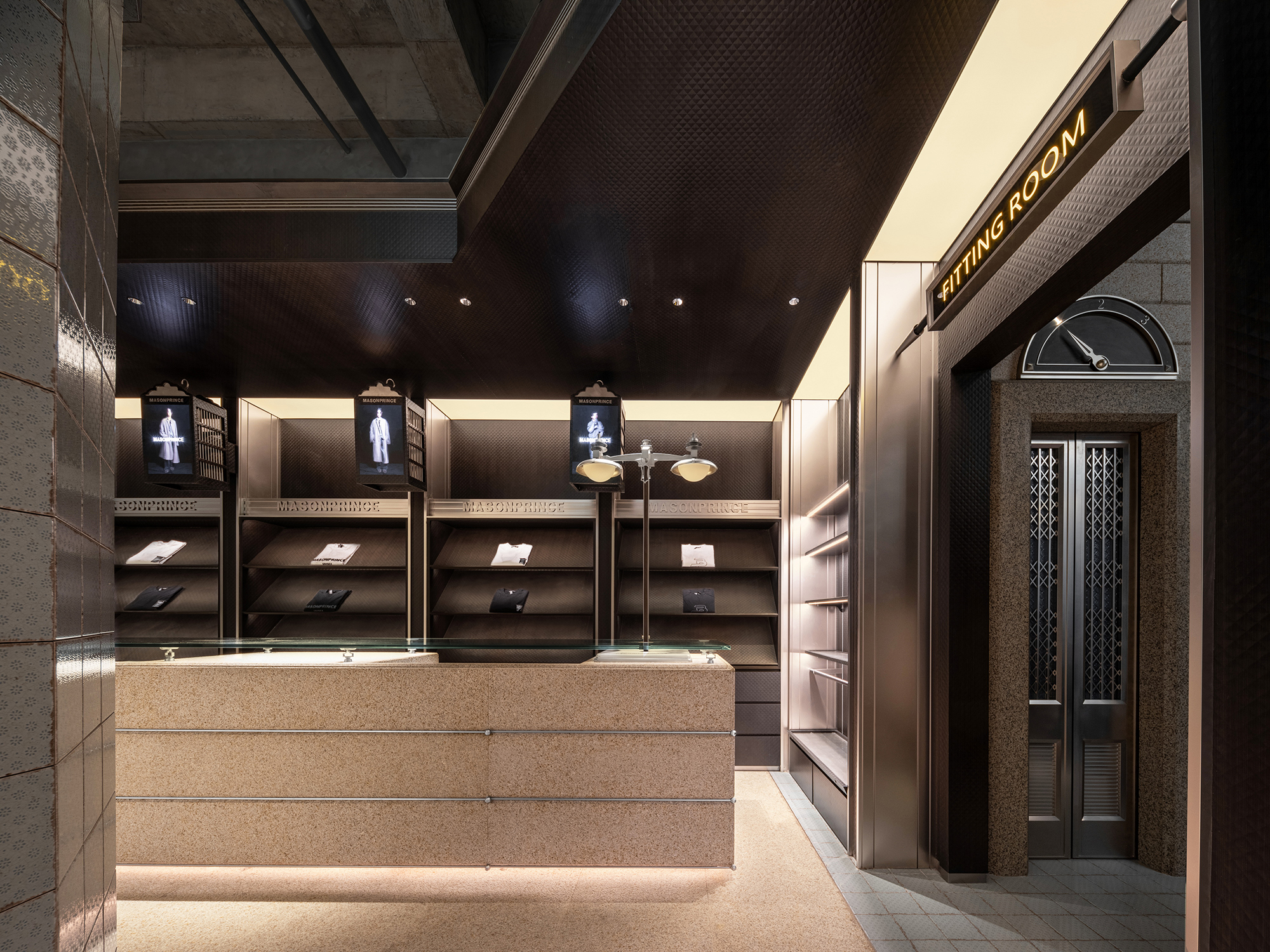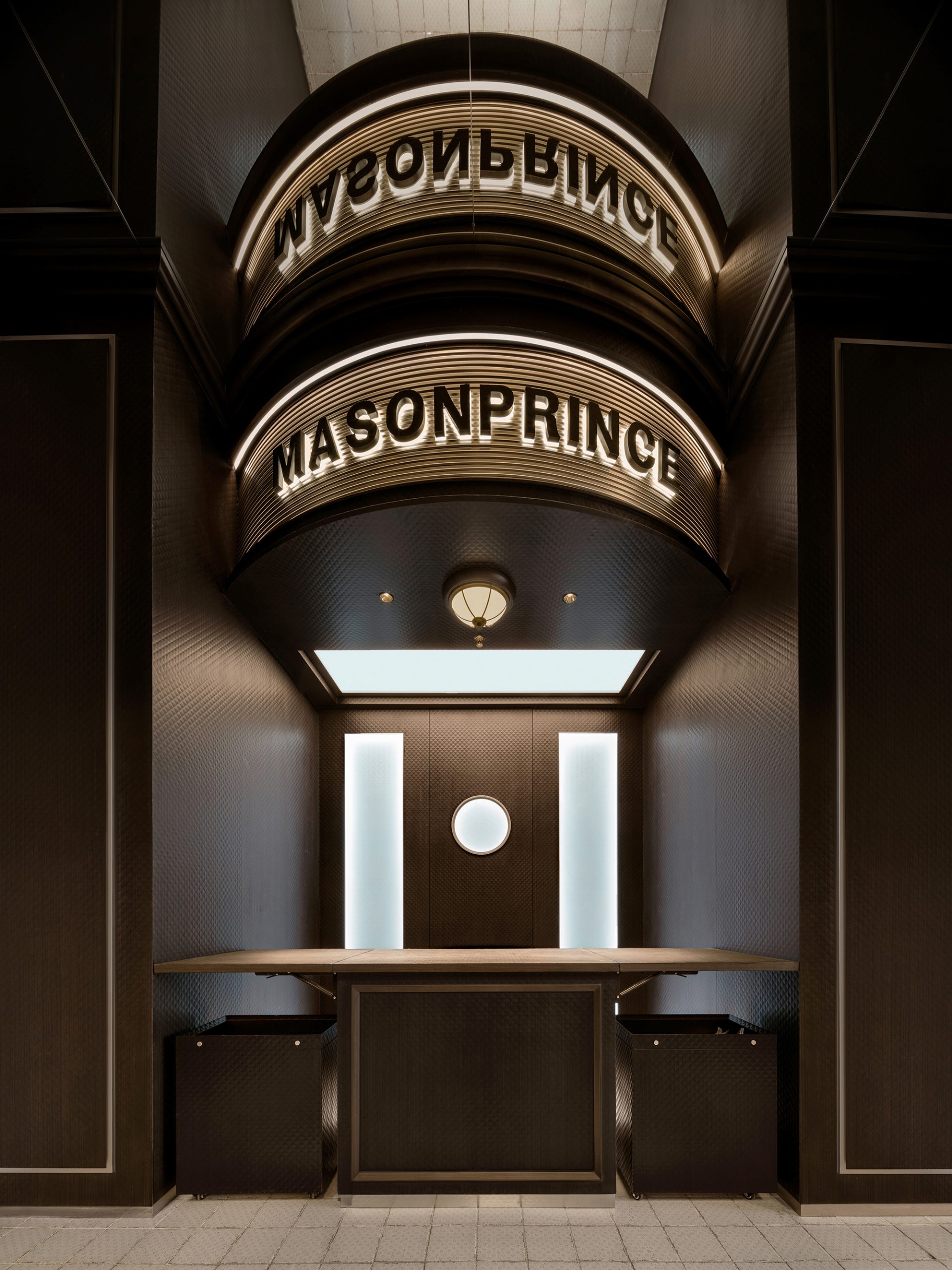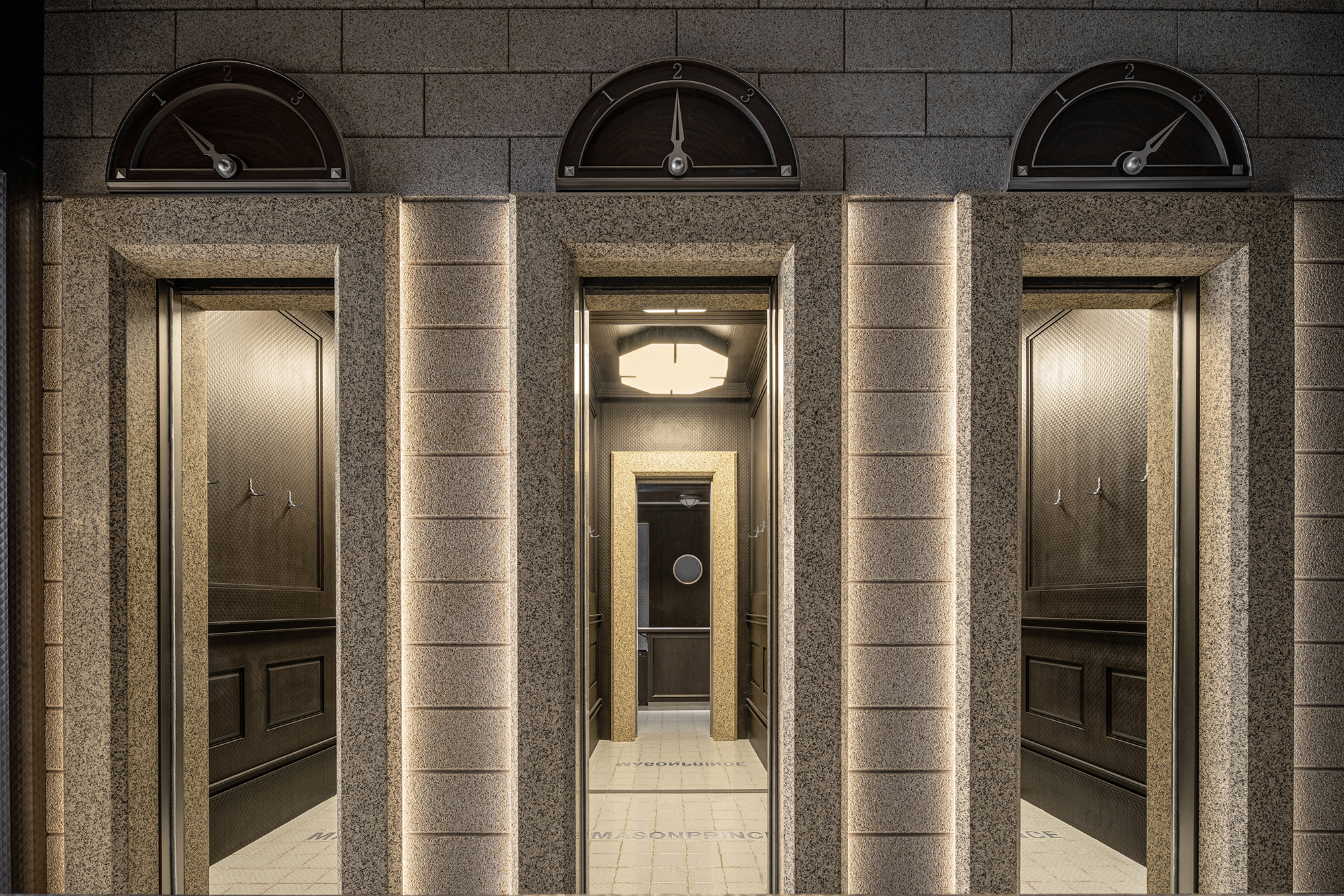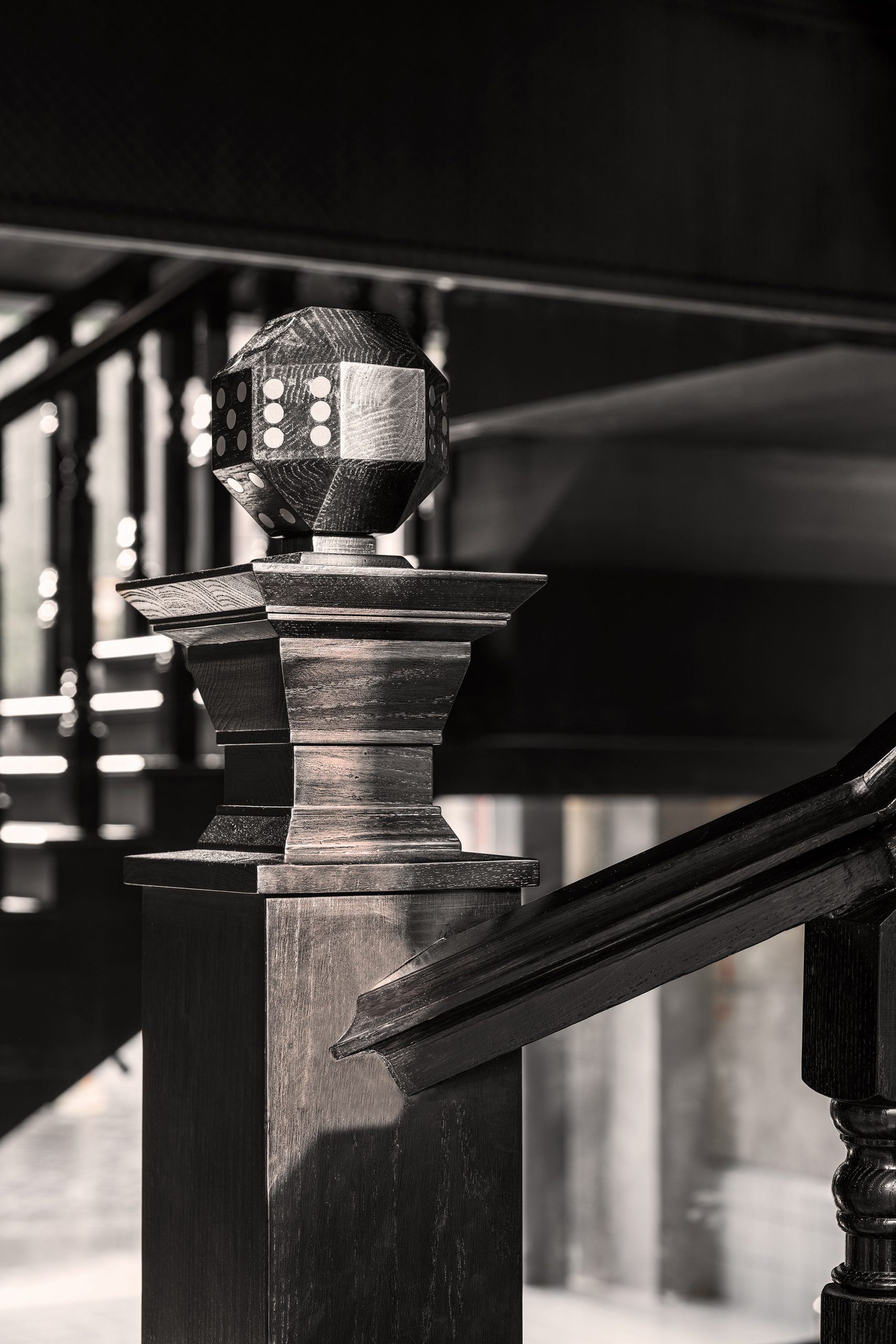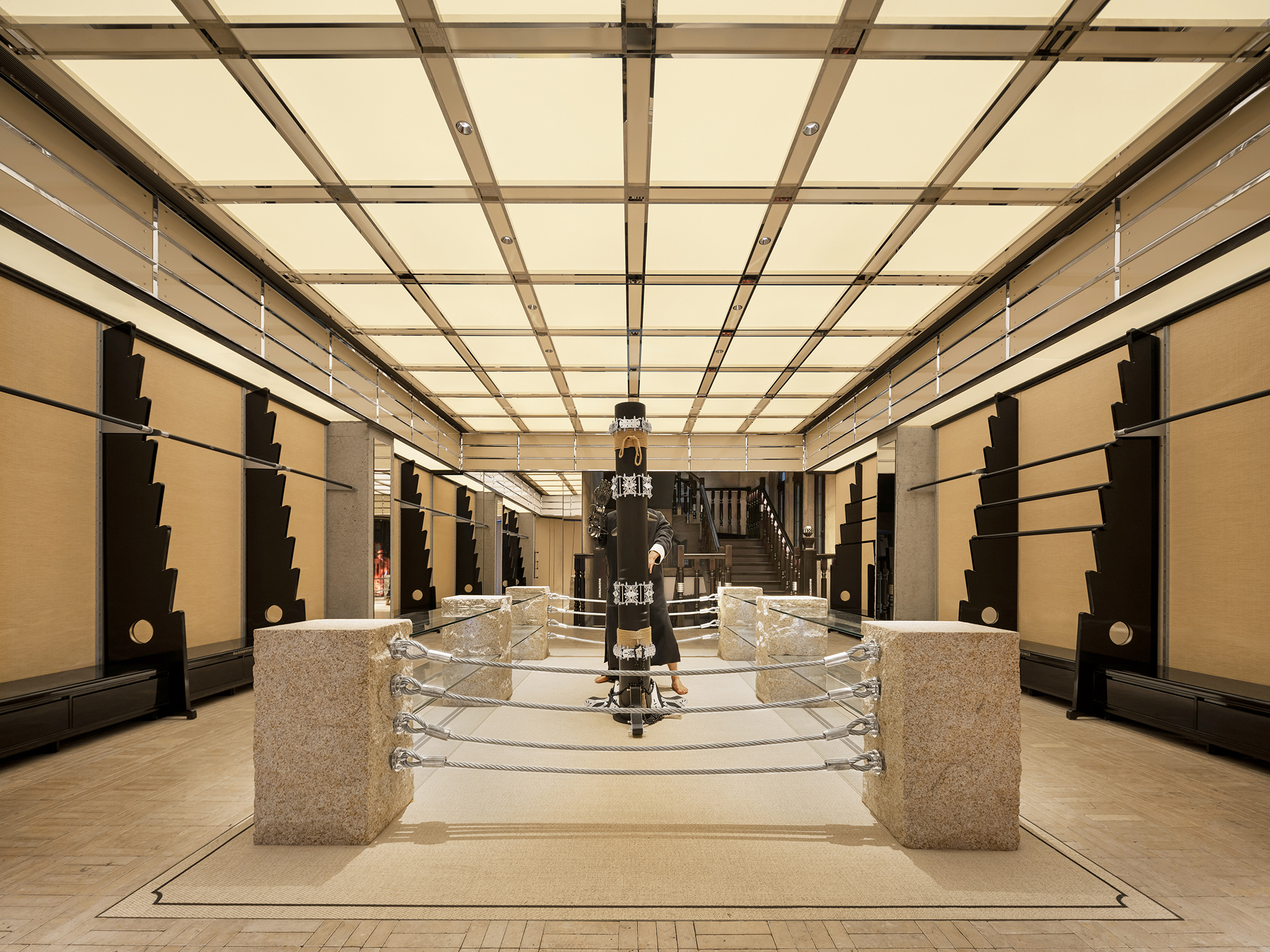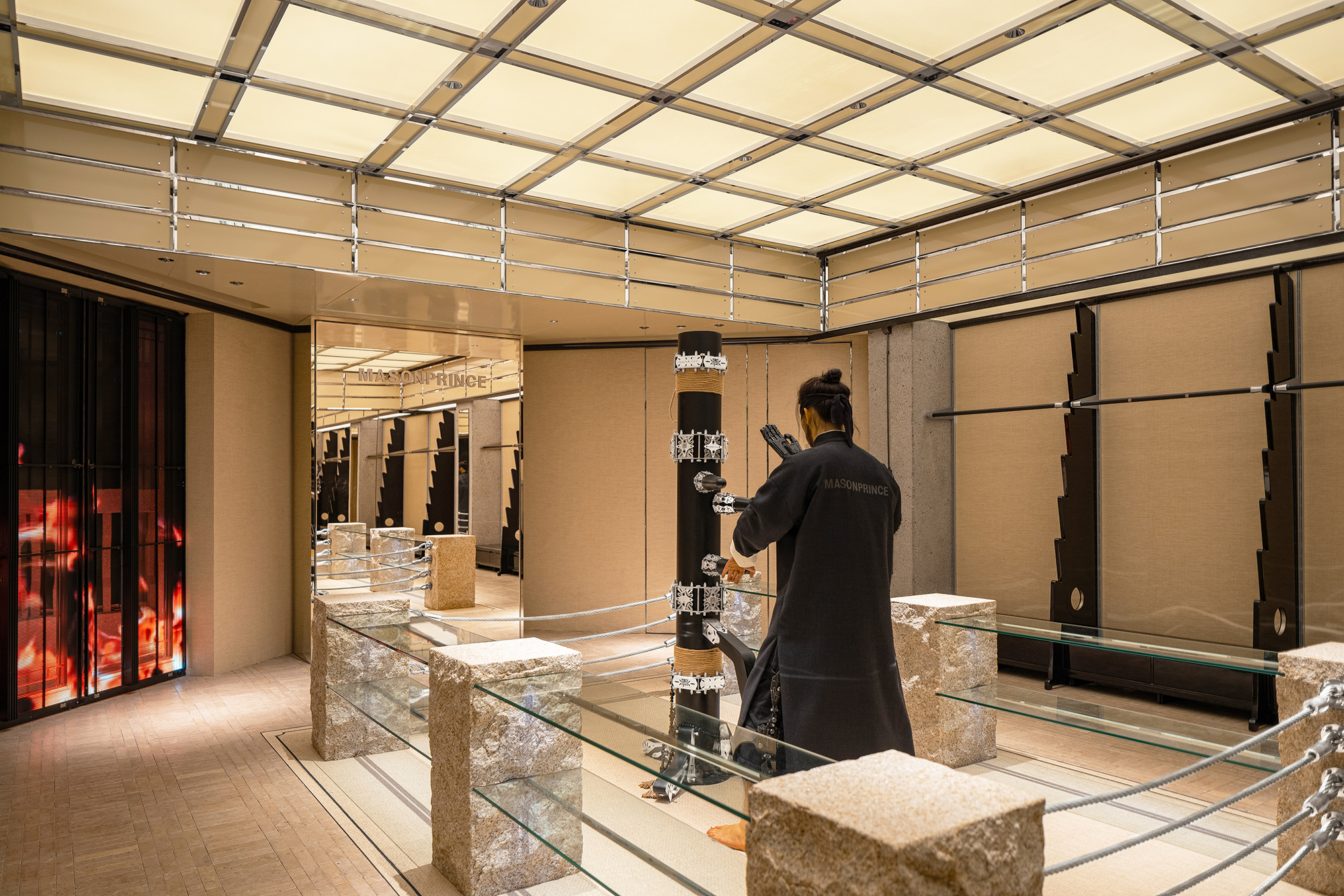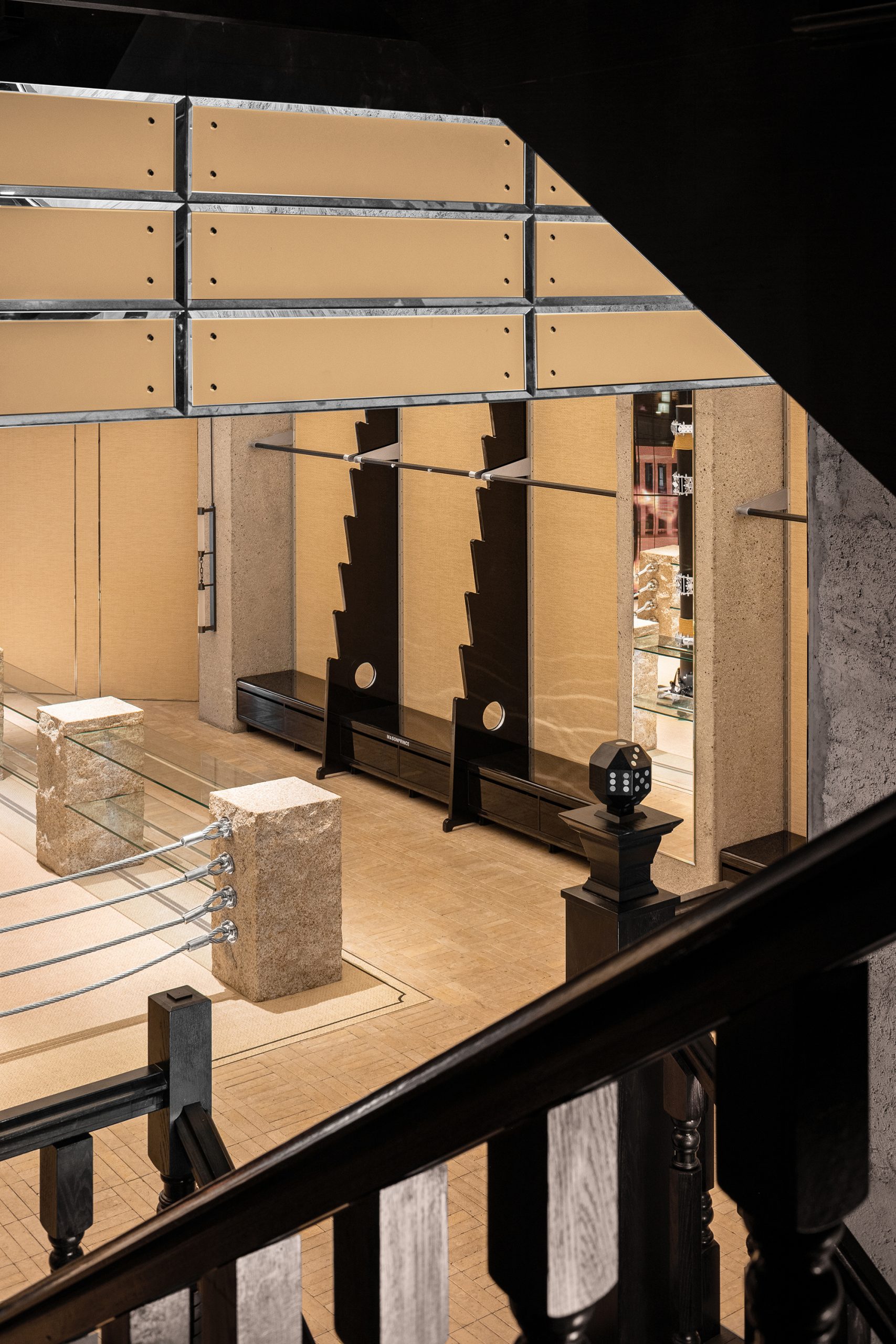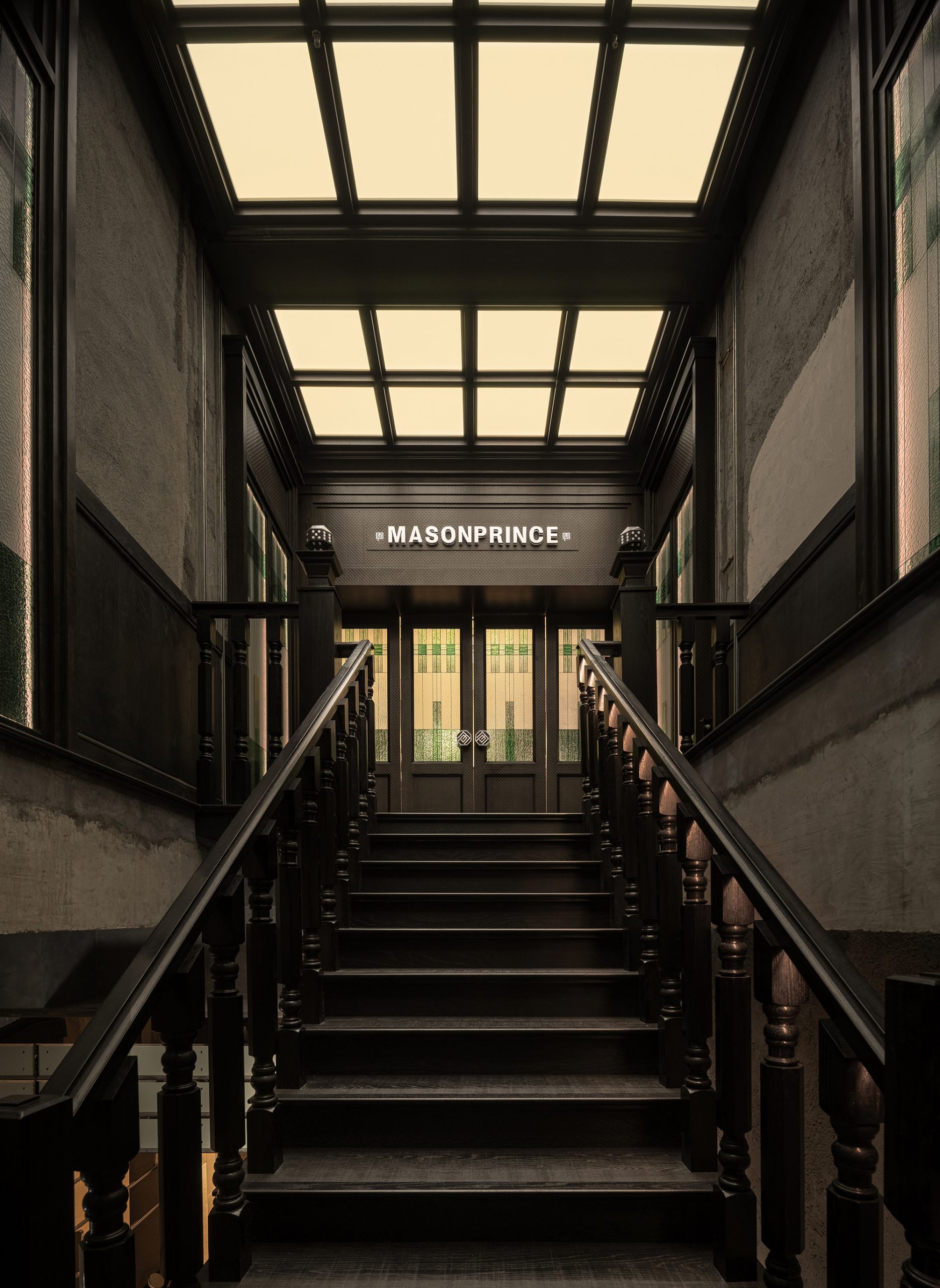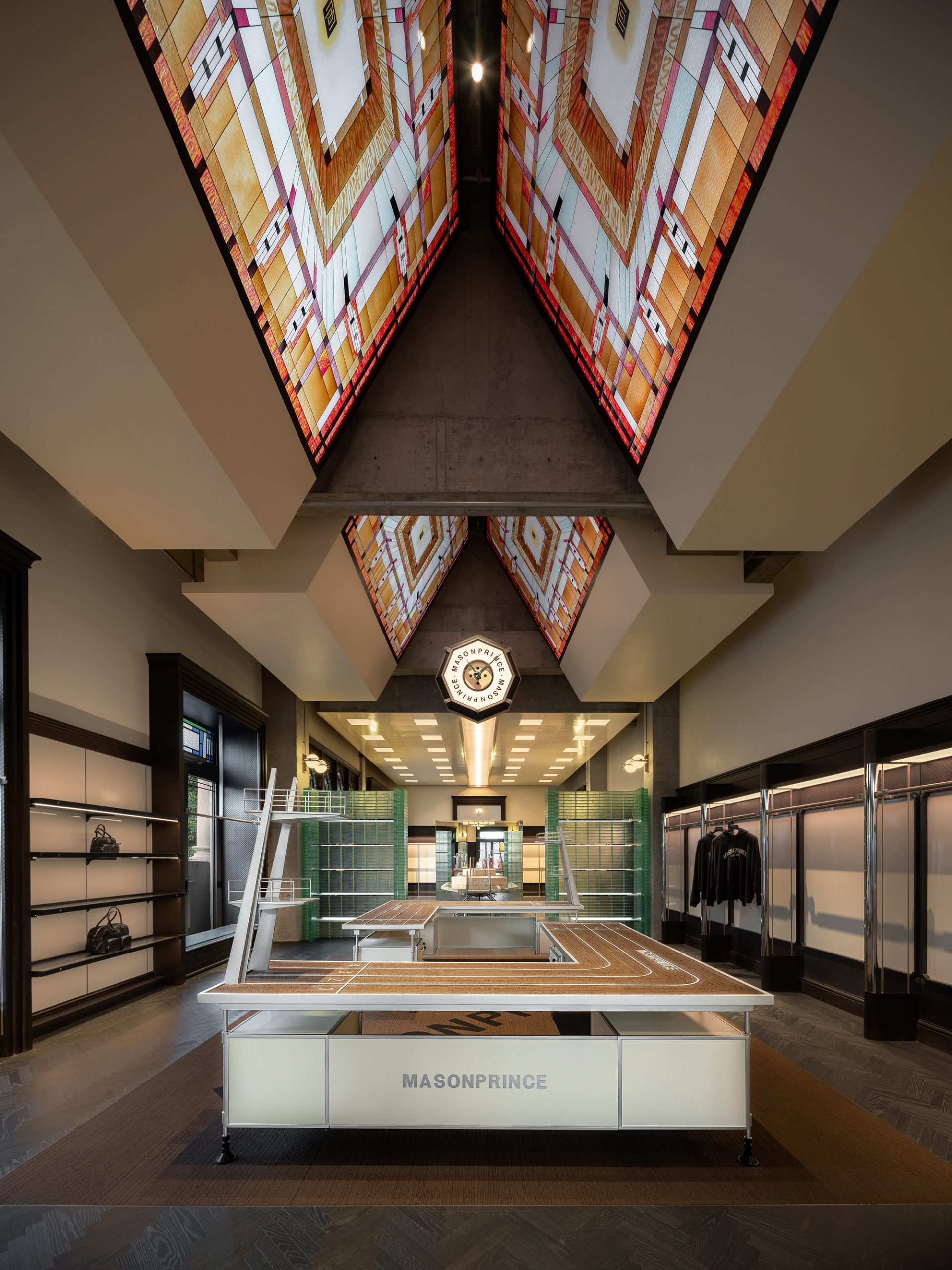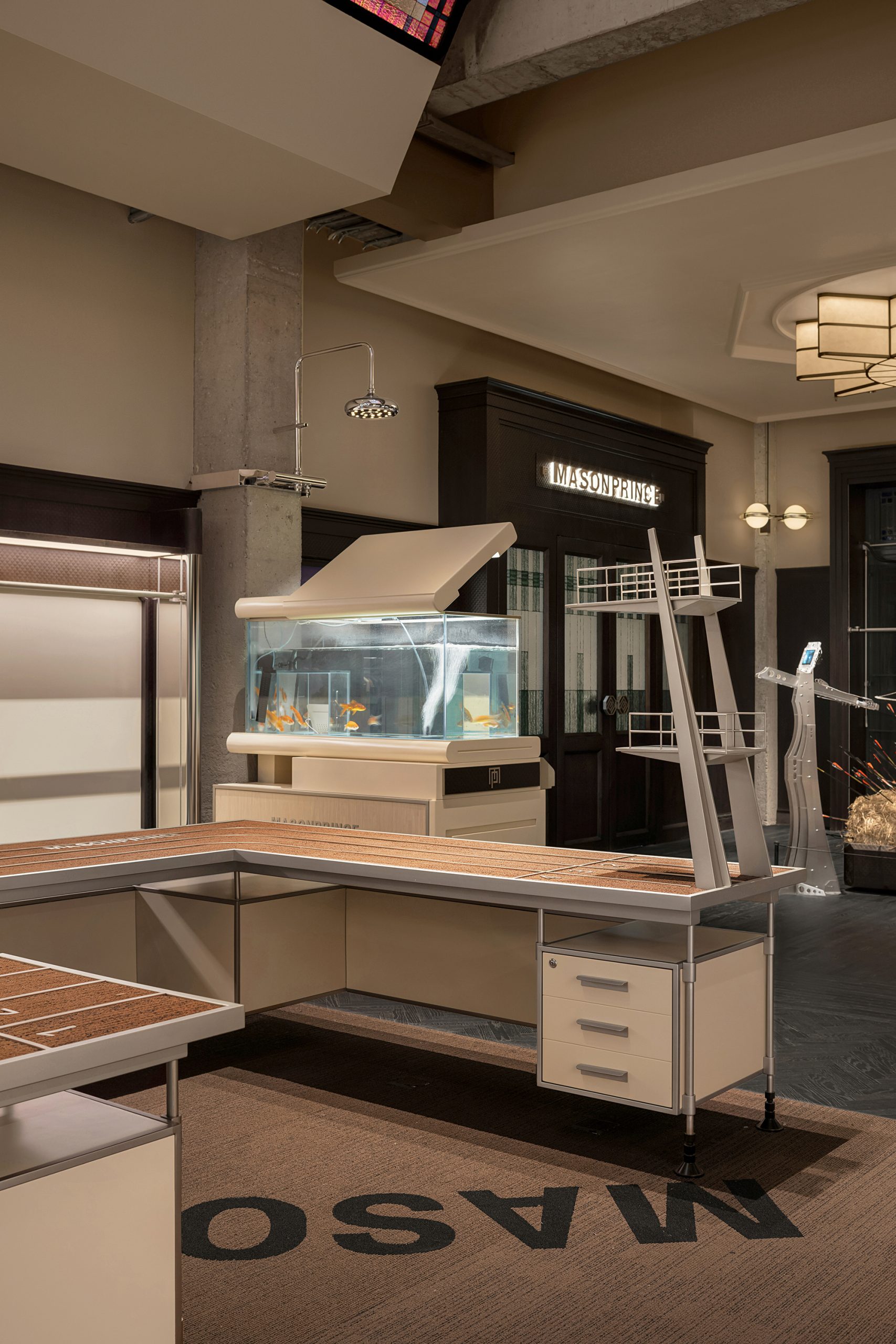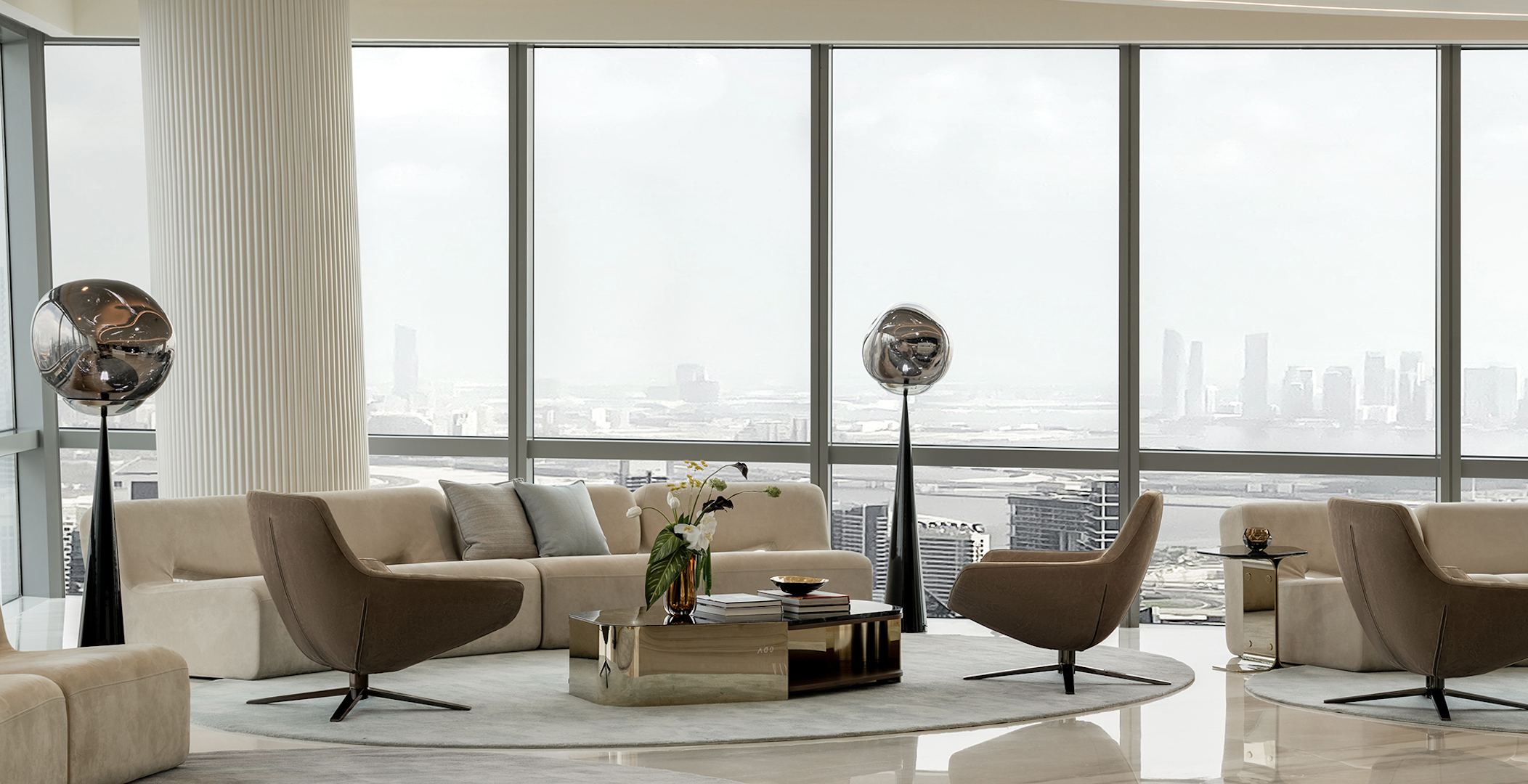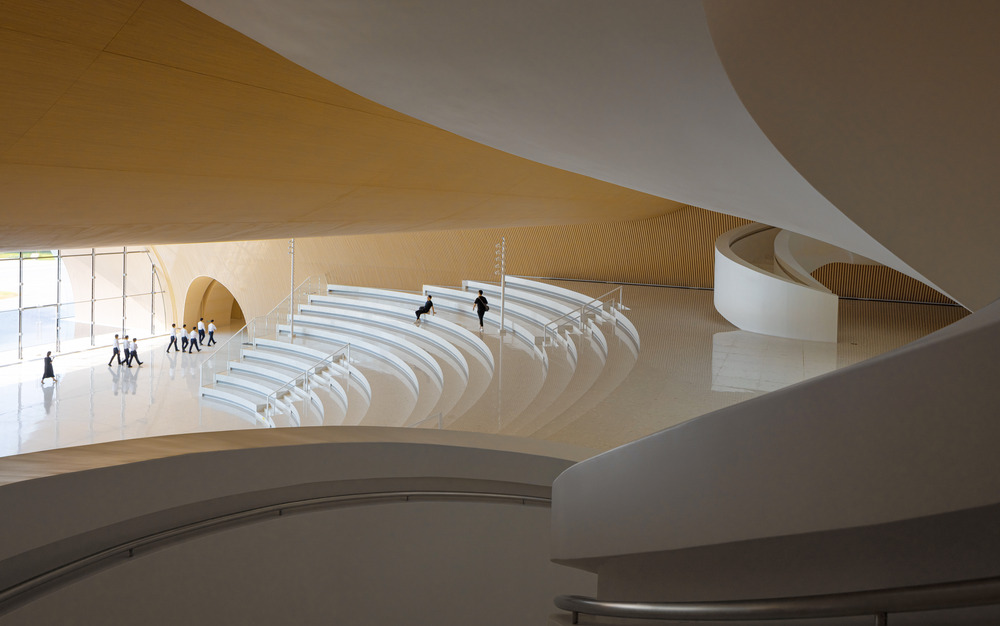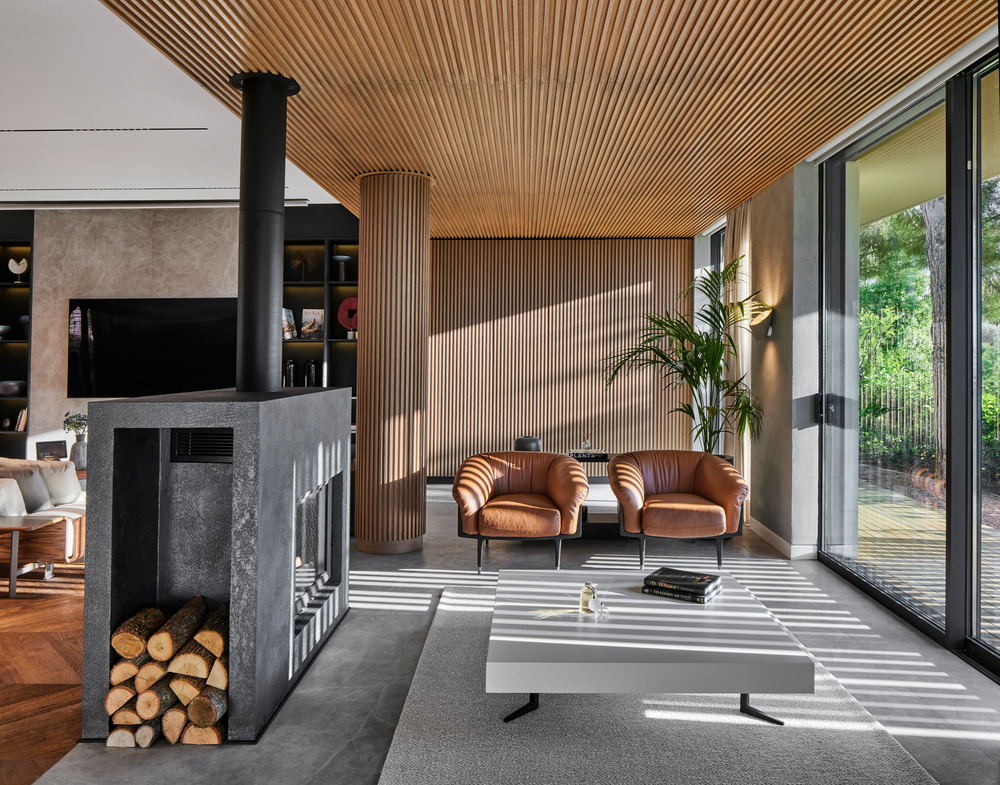The building’s facade showcases Lingnan architectural style. Blue bricks and gray tiles evoke the passage of time, while vibrant glass curtain walls bath this historic structure in a glow of the future. The flame of MASONPRINCE’s vision has ignited in Yongqingfang, heralding a new beginning for the convergence of culture and ideas.
- Photo credit: Free Will Photography
The first floor is designed with the concept of a “Tea House,” crafting a social retail space that blends classical Oriental aesthetics with cutting-edge contemporary design. MASONPRINCE warmly welcomes guests from all over the world, inviting them to savor moments of leisure and connection.
The entrance gate combines modern design with Lingnan heritage, featuring a quaint plaque and traditional Cantonese windows. From the first glance, it exudes the timeless elegance and cultural ambiance rooted in Sai Kwan.
A “roulette wheel” is cleverly placed above the central octagonal fountain pool, creating a harmonious coexistence with profound symbolism: “Turn of Fortune.” This design not only echoes an auspicious belief cherished by Cantonese people but also creates a visual highlight that elevates the space’s atmosphere.
The spatial layout draws inspiration from the octagon, a symbol of completeness and perfection in traditional Chinese culture. This geometric framework creates a balance of symmetry and dynamism.
Every wall and corner has been thoughtfully designed to maintain overall harmony while subtly defining different functional areas. Upon entering, customers are captivated by the play of light filtered through the stained glass.
Cantonese culture highly values good omens, with water symbolizing wealth and vitality. The flowing water converges within the installation, representing an endless stream of good fortune. Upon closer inspection, the retro metal components evoke the nostalgic memories of pinball machines, a beloved childhood pastime.
The perfectly symmetrical space, interwoven with mirrored reflections, creates a kaleidoscopic, dreamlike world. At the same time, it embodies the profundity, balance, and transformations inherent in Oriental cultural aesthetics.
Drawing inspiration from Eastern architectural aesthetics, the classic octagonal symbol, signifying “wealth from all directions,” permeates the space. From the retro-style ceiling light to decorative details, the space invites customers to trace an enduring classic language.
Ancient objects are reimagined through modern techniques, transforming into intriguing installations. For instance, the “scale,” symbolizing balance and symmetrical beauty, carries memories of the past and inspires spontaneous interaction. It invites customers to explore the space and engage with its cultural narratives.
Glazed fish ornaments, a distinctive feature of traditional Lingnan architecture’s eaves, is ingeniously integrated with the central column. The glass display stand surrounding the column, as blue as the sea and as green as jade, mirrors a tranquil water surface. The glazed fish, perched on the column, seems to leap out of the calm water, embodying agility and freedom, while conveying a transcendent and peaceful ambiance.
A fascinating connection emerges between the glazed fish column and the glass display stand. They transcend mere fixtures, serving as a bridge between reality and dreams, materiality and spirituality.
The display stand, made from retro transparent glass, echoes the building’s original stained glass windows, radiating vibrant Cantonese romance. It feels as though one is transported back to the bustling shops of the past century.
Incorporating the Cantonese tradition of koi fish-keeping, a revered symbol of luck and prosperity, the design adds a playful touch to the space’s curated displays.
A row of “birdcages” hangs gracefully in the air. The modern technological screens, combined with the imagery of caged birds, serve as a vessel of freedom and imagination, creating a striking contrast with the massive boulder-inspired front desk below.
The fair scale transforms into a table lamp, seamlessly integrating with the birdcages and boulder. Together, these elements construct a simple yet profound Oriental narrative: the birdcages represent agility, the boulder symbolizes stability, and the fair scale reflects delicate balance. They collectively speak to the cosmic mystery of harmonious coexistence.
Retro aesthetics intertwine with futurism, creating a space that stirs infinite imagination. Guided by clear and orderly lines, customers step into a fitting room where Chinese and Western lifestyles converge.
The clothes folding area takes inspiration from Western-style retro ticket counters, combining symmetrical design with metallic luster, mirrored surfaces, and dramatic lighting. This creates the illusion of being immersed in a quiet cinematic moment. The internal fitting rooms are inspired by elevator spaces, equipped with automated doors.
The fluid circulations of the space form a loop, converging at the staircase that leads to the second-floor “dojo.” Metal-textured walls and doors skillfully delineate spatial layers, achieving a balance between visibility and concealment.
Yongqingfang is home to the ancestral residence of Bruce Lee, the world-renowned Kung Fu legend. Bruce Lee famously coined the martial arts philosophy of “Be Water,” believing that true martial arts are concise, direct, and efficient. Inspired by this concept, the second-floor store space embraces purity and cohesion while celebrating simple, enduring Oriental aesthetics and the natural beauty of authenticity.
The entire space is grounded in a beige color palette, with rough square brick flooring creating a sense of historical resonance beneath every step—quiet yet powerful. Weapon racks, reimagined as clothing displays, bring to life the layout of traditional dojo.
A bionic figure slowly approaches the wooden dummy, its movements exuding mechanical precision and fluidity. It begins to move around the dummy, each step a finely-tuned dance of calculated precision—honoring ancient martial arts rhythms while incorporating the accurate control of modern technology.
At this moment, time seems to stand still, as a spiritual connection forms between the wooden dummy and the bionic martial artist—interdependent, each enhancing the other. Together, they weave a fascinating narrative of martial arts, technology, and consciousness.
The black wooden dummy and the bionic martial artist become the visual focal point of the space, paying homage to the spirit of traditional martial arts while reviving its practice through modern technology.
The weapon rack and scroll together represent the duality of this world. One symbolizes strength and courage, while the other embodies culture and artistry—hard versus soft, dynamic versus static.
The third floor takes “Guild Hall” as its design theme, cleverly integrating the imprint of the 1970s and 1980s Western department stores in Guangzhou with MASONPRINCE’s iconic “modern retro office” store identity.
This space represents a dialogue between the classic and the future. The unique “office” scenography of MASONPRINCE transcends mere functionality, creating a progressive spatial narrative across three interconnected areas in sequence.
The stairwell leading to the third floor is bathed in natural light filtering through the grid-pattern skylights. The handrails, reminiscent of Western-style influences found in ancient Cantonese houses, create a dialogue between contemporary lifestyle and Lingnan cultural context.

